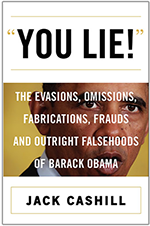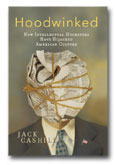Finally Cleared, Zimmerman
Should Sue the DOJ
Get your copy of Jack Cashill's latest book, "You Lie!"

___
Get your copy of Deconstructing Obama

___
Jack Cashill's book:
Hoodwinked: How Intellectual Hucksters have Hijacked American Culture
© Jack Cashill
AmericanThinker.com - February 26, 2015
“In all criminal prosecutions,” reads the Sixth Amendment to the U.S. Constitution, “the accused shall enjoy the right to a speedy and public trial.” In its dangling of George Zimmerman over the pit of judicial hell for the last three years, the Obama Department of Justice (DOJ) violated the spirit of that amendment for no better reason than to pacify the Democrats’ increasingly bloodthirsty base.
Finally, on Tuesday of this week, the DOJ announced that it had found insufficient evidence to pursue federal criminal civil rights charges against Zimmerman. A White House so seemingly appalled by torture had no qualms about torturing Zimmerman needlessly for nearly three years. Indeed, within months of the February 26, 2012, shooting death of Trayvon Martin in Sanford, Florida, the DOJ knew it had no criminal case against Zimmerman, but it kept dangling him nonetheless.
On March 19, 2012, ABC reported that the FBI, the Justice Department's Civil Rights Division, and the U.S. Attorney's Office for the Middle District of Florida would all investigate Martin’s death. By Monday, April 2, 2012, FBI agents were already in Florida questioning individuals in an Orwellian "parallel investigation" that focused less on Zimmerman’s actions that fateful night than on his thoughts, past and present.
Did Zimmerman really say “coon” on his call to the dispatcher? Had he ever told a racial joke? Were the suspicious persons he reported to the police disproportionately black? In contemporary America words often mattered more than action.
By day two of the FBI investigation, FBI agents were grilling Sanford PD’s lead investigator, Chris Serino. What the agents failed to understand was that if the civil rights of anyone had been abused, that person was Zimmerman. For starters, Serino viewed Zimmerman as “not a racist.” Wrote the agents, “Serino believed that ZIMMERMAN’S actions were not based on MARTIN’S skin color rather based on his attire, the total circumstances of the encounter and the previous burglary suspects in the community.”
That much said, Serino Zimmerman little credit for his actions and gave Martin too much for his. He worked under the assumption that Zimmerman had reached a “faulty conclusion” about Martin’s activity at the time Zimmerman spotted him. He told Zimmerman early on, “This child has no criminal record whatsoever.” He called Martin “a good kid, a mild-mannered kid.” By April 3, when the FBI interviewed him, Serino should have known about Martin’s troubled history with the Miami-Dade Schools Police Department (M-DSPD). It seems likely that his own colleagues blocked him.
On February 29, three days after the shooting, a Sanford PD sergeant sent a request to the M-DSPD asking for information on Martin. This was to include information on his “arrest history/cases with you or local agencies.” The M-DSPD searched the department’s record management system, located the relevant eight-page report, faxed it to Sanford and then called to confirm he had received it.
A few weeks later, on March 26, the Miami Herald ran a story headlined, “Multiple Suspensions Paint Complicated Portrait of Trayvon Martin.” The article detailed much of Martin’s wayward behavior including his apprehension at his Miami high school with stolen jewelry and a burglary tool. For reasons not fully established, however, the information sent by the M-DSPD never made it into the SPD’s final victimology report.
One reason may have been that the black Sanford PD sergeant who requested the report showed little interest in learning about Martin’s criminal behavior. In his sworn affidavit to the Internal Affairs division of M-DSPD, the sergeant conceded that he knew little about Martin’s record “other than what I heard in the news.” And what news he heard went no deeper than that of a “baggy or something” found in Martin’s backpack.
Serino was feeling the heat, and he said as much to the FBI. He was concerned with another black Sanford PD officer, one who was “friendly” with Trayvon’s father, Tracy Martin. For his part, that same officer told the FBI that the black community might well be “in an uproar” if Zimmerman were not charged. The FBI quoted him as saying, “The community will be satisfied if an arrest takes place.”
The need to satisfy this community pressure led the brass of two police departments, the State of Florida, and the U.S. Department of Justice to conspire to arrest George Zimmerman, himself a minority. If that were not a civil rights violation, it would be hard to identify what a violation was.
In early July 2012, the State of Florida released to Zimmerman’s attorneys the results of the FBI’s investigation into Zimmerman’s racial bona fides. The State may have been sitting on these reports for a while. As the Miami Herald reported, the FBI had interviewed some thirty-five of Zimmerman’s friends, neighbors, and co-workers and, to a person, they “had never seen Zimmerman display any prejudice or racial bias.”
The most revealing of the FBI interviews was with Zimmerman’s one-time fiancée, herself Hispanic, with whom he lived for a period of time. Although not at all hesitant to document his imperfections, the young woman thought Zimmerman to be “last person in the world” she would expect to be involved in the shooting of Trayvon Martin. He “never exhibited any biases or prejudices against anyone,” she told the FBI, “and did not use racial epithets of any kind.”
Not surprisingly, the State’s release of the FBI information made little dent in the news. For its part, the Martin family attorneys worked relentlessly to keep the racial edge sharp. Appearing on ABC’s The View the last weekday before the trial began, Benjamin Crump assured the openly sympathetic Whoopi Goldberg that Martin’s death was “certainly a civil rights case.” And while he talked about Martin, large photos of a cherubic pre-teen floated behind them. The propaganda never stopped.
As a side note, while the FBI investigation was taking place, Attorney General Eric Holder addressed Al Sharpton’s National Action Network in Washington, D.C. There, improbably, he thanked Sharpton “for your partnership, your friendship, and your tireless efforts to speak out for the voiceless, to stand up for the powerless, and to shine a light on the problems we must solve, and the promises we must fulfill.” This was, of course, the same Al Sharpton who had threatened to occupy Sanford if Zimmerman were not arrested immediately. Holder did have one thing right. Sharpton was tireless, but he was a solution to no known problem.


